Table of contents
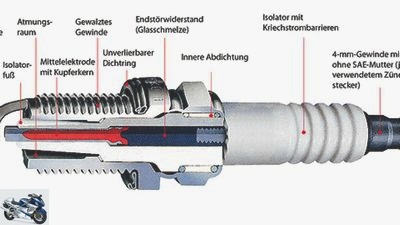
Schermer
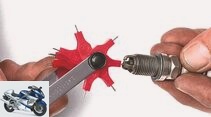
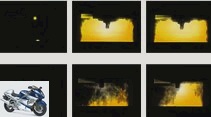
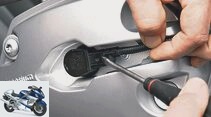
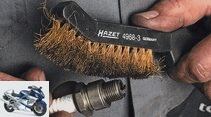
8th pictures
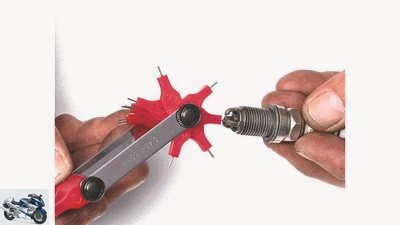
Schermer
1/8
The correct distance can be found in the manual. Use a lot of feeling when re-bending.
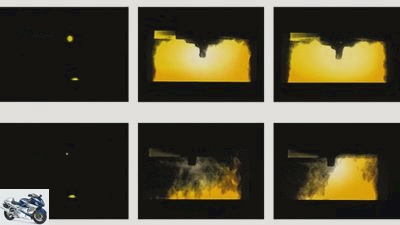
Schermer
2/8
Above the spark of the Iridium candle, below the spark of the standard candle.
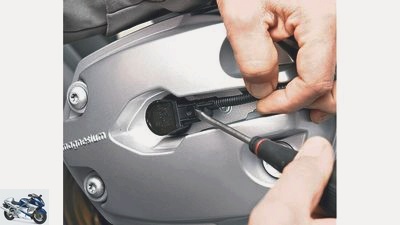
Schermer
3/8
Carefully pull off the spark plug connector, if necessary release the locks to avoid damage.
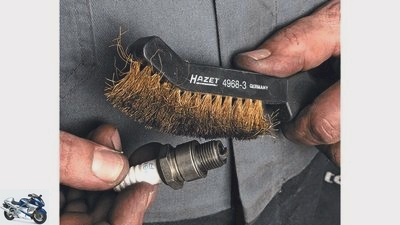
Schermer
4/8
Only clean spark plugs with a brass brush. Steel is absolutely taboo.
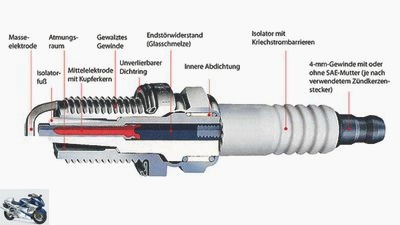
Schermer
5/8
When changing spark plugs, it is never wrong to know how the spark plug is constructed: construction of a spark plug. Compared to spark plugs used in passenger cars, motorcycle spark plugs have a much slimmer design.
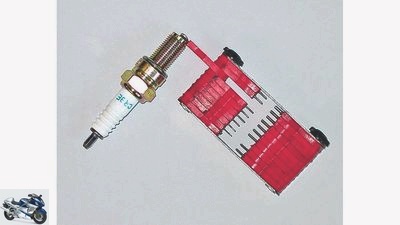
Schermer
6/8
An important test point is the electrode gap, which must be checked using a feeler gauge.
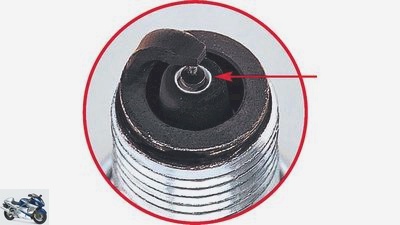
Schermer
7/8
In the case of Iridium candles, the annular gap remains free of deposits. The pilot lights here are significantly larger than with standard candles.
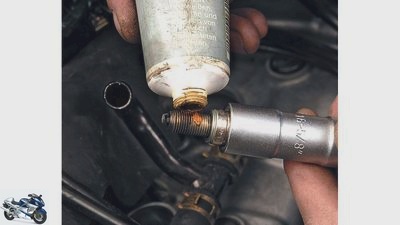
Schermer
8/8
When installing, put a drop of ceramic paste on the thread of the spark plug.
counselor
technology & future
Adviser: change spark plugs
Adviser: change spark plugs
Everything about spark plugs
No thunder without lightning: Spark plugs ensure that the sucked-in mixture is ignited and burns cleanly. In this chapter of our technology series you will find everything to do with spark dispensers.
Jorg Lohse
03/31/2010
The age of the spark plugs does not determine whether they need to be replaced. First and foremost, mileage and load count. If the motorcycle is mainly in the city with a lot of start-stop, you have to pay more attention to the spark plug than if the machine is usually driven quickly in the middle to high speed range on open roads.
Particularly high-quality spark plugs have a very thin center electrode made of platinum or iridium. At 0.8 to 1.2 mm, this is much thinner than that of a standard spark plug
Service spark plugs
- Have the tools ready: If the spark plugs are set high, the plug wrench from the vehicle tool kit is sufficient for removal and installation.
- With deep-seated spark plugs, as is common in modern engines with two overhead camshafts, you need a long spark plug wrench with an inserted rubber ring as an assembly aid that securely holds the plug in place during removal and installation.
- If the spark plug is to be tightened to the prescribed torque, a corresponding spark plug socket is required for the torque wrench.
(approx. 2.5 mm), therefore heats up more quickly and has less surface on which combustion residues can adhere.
Remove spark plugs
Attention: Always pull off the spark plug connector by hand and put it on! Do not use pliers to help! Also, do not pry it with a tire changer, screwdriver or flat iron, as this can damage the spark plug connector. Do not drop the spark plug connector or removed spark plug! This can cause parts to break or crack, causing open circuits or short circuits.
Exceptions are the rule: In recent times, combined spark plug connector and ignition coils have been increasingly used, i.e. the long spark plug connectors with the small electrical connector on the head. In the course of time, these components get stuck on the spark plug and in the spark plug shaft of the cylinder head and are accordingly difficult to remove:
- Unplug the electrical plug: Press the latch on the side of the plug and pull the plug at the same time, but NOT the electrical cable.
- Loosen the spark plug connector by turning it before removing it.
- Carefully pull it off and off by hand.
- If he doesn’t want to get out: VERY carefully pry the socket with a tire lever.
expansion
- Remove cladding parts so that there is enough space for clean work.
- Pull off the spark plug connector.
- Blow compressed air from above between the cooling fins and into the spark plug shaft and blow any dirt out of the spark plug shaft.
- Loosen the spark plug with the spark plug wrench and remove it.
Spark plug check
Correct electrode spacing is particularly important for the proper functioning of the spark plug. If this is not correct, it must be corrected. However, the electrodes may only be bent back a little, because if the electrode is bent too violently or too often, there is a high risk of breakage during operation. If in doubt, it is better to use a new candle.
The prescribed electrode gap is usually 0.8 to 0.9 millimeters, which differs from engine to engine (please refer to the vehicle manual to find out which electrode gap applies to your engine). The wear limit is 0.9 to 1.0 millimeters.
Measure and correct the electrode gap
- Measure the electrode gap with a feeler gauge.
- If the distance is too far (which is usually the case with a used spark plug), hold the spark plug upside down, pick up a screwdriver the wrong way round and tap the electrode very lightly with the handle: Better one hit too little than one too many!
- If the outer electrode was accidentally tapped too hard, i.e. the electrode gap is too narrow, carefully bend it open again with a small electric screwdriver. It is even better to bend the electrode up with small flat-nose pliers.
- In any case, the following applies: Be careful when setting the electrode gap, otherwise the earth electrode can break off and the spark plug is broken!
Install spark plugs
- For new or used spark plugs in an older motorcycle: Put a small drop of ceramic paste on the thread of the spark plug; this lubricates the thread and prevents the plug from sticking.
- Insert the spark plug in the spark plug wrench and insert it carefully by hand into the spark plug shaft without hitting anything, place it on the thread and screw it in.
- Screw the spark plug into the thread until resistance can be felt, then tighten with the specified tightening torque.
- If a torque wrench is not available, proceed as follows:
- Used spark plug where the sealing ring has already set: Tighten the spark plug by approx. 1/8 of a turn after the threaded collar is seated.
- New spark plug with new sealing ring: after the threaded collar is seated, tighten the spark plug by 1/4 to 1/2 turn, loosen again and finally tighten by 1/8 turn.
Attention: When screwing in the spark plugs, make sure that the first thread engages correctly, i.e. that the external thread of the plug is correctly positioned on the internal thread in the cylinder head. The hard steel thread of a plug placed at an angle will ruin the soft thread in the aluminum cylinder head after only half a turn. Depending on the thread diameter of the spark plug, the following tightening torque values apply:
- Thread 8 mm 8 to 10 Nm
- Thread 10 mm 10 to 12 Nm
- Thread 12 mm 15 to 20 Nm
- Thread 14 mm 25 to 30 Nm
- Thread 18 mm 35 to 40 Nm
More about technology
PS knowledge: technology
- Motorcycle technology clearly explained on 97 pages (PDF)
- From starter to spark plug
- Simple teaching of physical principles
- Tips and tricks for practitioners
To the PDF for € 9.99
#image.jpg
Related articles
-
Cook counselor workshop Adviser: Change Simmerrings Adviser: Change Simmerrings Change the oil seals on the telescopic fork If the fork oil finds its way…
-
Adviser: change the wheel bearing
Schermer 7th pictures Schermer 1/7 Changing the wheel bearing Step 7: When driving in, carefully tap into the outer ring with a mandrel.. Schermer 2/7…
-
Adviser: change the steering head bearing
Schermer counselor workshop Adviser: change the steering head bearing Adviser: change the steering head bearing Check and replace steering head bearings…
-
Screwdriver tip oil change and oil level check
Photo: mps photo studio 14th pictures Honda 1/14 Screwdriver tip – oil change and oil level check. Ralf Petersen 2/14 Preparation: All of this is needed….
-
Advice: change fork oil and springs
Schermer counselor workshop Advice: change fork oil and springs Advice: change fork oil and springs Replace fork oil and springs Because abrasion and…
-
Schermer counselor workshop Advice: change fork Advice: change fork Remove and install the fork properly Simmerring leaking? Fork oil change due? Replace…
-
counselor technology & future Spark plug: heat value Spark plug: heat value Spark plug: heat value The heat value indicates the thermal load capacity of…
-
counselor workshop Change the air filter Change the air filter Change the air filter Fuel consumption too high? Rough engine run? A dirty air filter can…
-
Change brake discs yourself – tips and tricks
Markus Jahn 9 pictures Ralf Schneider 1/9 There is a need for action here! The heat spots on the panes shown on the left can certainly no longer be…
-
Varta counselor workshop Adviser: the battery Adviser: the battery Everything about the battery It’s almost close, the season is about to start. In order…